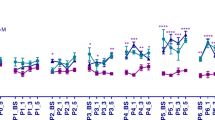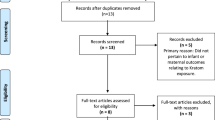Abstract
Nalbuphine is an inexpensive, non-controlled, opioid analgesic that has been in clinical use for decades. A kappa opioid receptor agonist and mu opioid receptor antagonist, nalbuphine causes fewer adverse effects than other opioid analgesics. The author reviews the characteristics of nalbuphine, analyzes studies of nalbuphine in mice and explores the potential use of nalbuphine to treat pain in research mice. In analgesiometric studies in mice, nalbuphine ameliorates both somatic and visceral pain. Nalbuphine seems to have a broad range of safe doses for subcutaneous administration in mice. Unlike non-steroidal anti-inflammatory drugs, nalbuphine does not antagonize prostaglandins or impede labor in mice. Although additional study is needed before clinical use can be recommended, evidence presented here suggests that nalbuphine might be an effective analgesic for dystocia (or difficult birth) and other painful conditions in research mice.
This is a preview of subscription content, access via your institution
Access options
Subscribe to this journal
We are sorry, but there is no personal subscription option available for your country.
Buy this article
- Purchase on Springer Link
- Instant access to full article PDF
Prices may be subject to local taxes which are calculated during checkout
Similar content being viewed by others
References
National Research Council (US) Committee on Recognition and Alleviation of Pain in Laboratory Animals Recognition and Alleviation of Pain in Laboratory Animals (National Academies Press, Washington, DC, 2009).
ACLAM Guidelines for the Assessment and Management of Pain in Rodents and Rabbits (July 2006) http://www.aclam.org/education-and-training/position-statements-and-reports.
Narver, H.L. Oxytocin in the treatment of dystocia in mice. J. Am. Assoc. Lab. Anim. Sci. 51, 10–17 (2012).
Fish, R.E., Brown, M.J., Danneman, P.J. & Karas, A.Z. (eds.) Anesthesia and Analgesia in Laboratory Animals 2nd edn. (Elsevier, London, 2008).
Fox, J.G. et al. (eds.) The Mouse in Biomedical Research: Diseases vol. 2, 2nd edn. (Academic, Burlington, MA, 2007).
Winchester, S.K. et al. Coordinate regulation of prostaglandin metabolism for induction of parturition in mice. Endocrinology 143, 2593–2598 (2002).
Errick, J.K. & Heel, R.C. Nalbuphine. A preliminary review of its pharmacological properties and therapeutic efficacy. Drugs 26, 191–211 (1983).
Kshirsagar, S., Gear, R., Levine, J. & Verotta, D. A mechanistic model for the sex-specific response to nalbuphine and naloxone in postoperative pain. J. Pharmacokinet. Pharmacodyn. 35, 69–83 (2008).
Woollard, M. et al. Less IS less: a randomized controlled trial comparing cautious and rapid nalbuphine dosing regimens. Emerg. Med. J. 21, 362–364 (2004).
Gunion, M.W., Marchionne, A.M. & Anderson, C.T.M. Use of the mixed agonist-antagonist nalbuphine in opioid based analgesia. Acute Pain 6, 29–39 (2004).
Anderson, D. A review of systemic opioids commonly used for labor pain relief. J. Midwifery Womens Health 56, 222–239 (2011).
Benson, G.J. & Tranquilli, W.J. Advantages and guidelines for using opioid agonist-antagonist analgesics. Vet. Clin. North Am. Small Anim. Pract. 22, 363–365 (1992).
Pick, C.G., Paul, D. & Pasternak, G.W. Nalbuphine, a mixed kappa1 and kappa3 analgesic in mice. J. Pharmacol. Exp. Ther. 262, 1044–1050 (1992).
Patrick, C.A., Holden Ko, M.C. & Woods, J.H. Comparison of antinociceptive effects induced by kappa opioid agonists in male and female mice. Analgesia (Elmsford NY) 4, 397–404 (1999).
Wong, C.L. & Wai, M.K. Increased naloxone potency induced by pretreatment with morphine and nalbuphine in mice. Clin. Exp. Pharmacol. Physiol. 11, 301–307 (1984).
Wong, C.-L. The effect of nalbuphine on gastrointestinal transit in mice. Eur. J. Pharmacol. 135, 219–223 (1987).
Stav, A., Rabinowitz, R. & Korczyn, A.D. Actions of opioid agonist-antagonist drugs on the pupil and nociceptive responses in mice. J. Anesth. 6, 439–445 (1992).
Ortiz, M.I. et al. Evaluation of the interaction between acemetacin and opioids on the Hargreaves model of thermal hyperalgesia. Pharmacol. Biochem. Behav. 88, 47–54 (2007).
Drug Enforcement Administration, Office of Diversion Control, Drug and Chemical Evaluation Section. Nalbuphine Hydrochloride (August 2013). http://www.deadiversion.usdoj.gov/drug_chem_info/nalbuphine.pdf.
Hospira, Inc. Material Safety Data Sheet: Nalbuphine Hydrochloride Injection. http://www.hospira.com/Images/MSDS_Nalbuphine_Hydrochloride_Injection_060214_81-95520_1.pdf.
Definition of Controlled Substance Schedules http://www.deadiversion.usdoj.gov/schedules/.
Liao, C.C. et al. Efficacy of intramuscular nalbuphine versus diphenhydramine for the prevention of epidural morphine-induced pruritus after cesarean delivery. Chang Gung Med. J. 34, 172–178 (2011).
Kim, T.H., Kim, J.M., Lee, H.H., Chung, S.H. & Hong, Y.P. Effect of nalbuphine hydrochloride on the active phase during first stage of labor: a pilot study. J. Obstet. Gynaecol. 31, 724–727 (2011).
Wagner, A.E., Worland, G.A., Glawe, J.C. & Hellyer, P.W. Multicenter, randomized controlled trial of pain-related behaviors following routine neutering in dogs. J. Am. Vet. Med. Assoc. 233, 109–115 (2008).
Lee, C.H., Lin, S.L., Chi, T.T., Chang, S.H. & Wang, H.C. Effect of topical administration of 0.8% nalbuphine on the cornea of dogs after phacoemulsification. J. Vet. Med. Sci. 75, 1041–1047 (2013).
Coetzee, J.F., Lechtenberg, K.F., Stock, M.L. & Kukanich, B. Pharmacokinetics and effect of intravenous nalbuphine in weaned Holstein calves after surgical castration. J. Vet. Pharmacol. Ther. 37, 169–177 (2014).
Ho, S.T. et al. The antinociceptive effect of long-acting nalbuphine preparation in rabbits. Acta Anaesthesiol. Sin. 41, 99–103 (2003).
Kruger, L. (ed.) Methods in Pain Research (CRC, Boca Raton, FL, 2001).
Kuzmin, A.V., Gerrits, M.A.F.M., Zvartau, E.E. & van Ree, J.M. Influence of buprenorphine, butorphanol, and nalbuphine on the initiation of intravenous cocaine self-administration of drug naïve mice. Eur. Neuropsychopharmacol. 10, 447–454 (2000).
Frey, H.H. Effect of mu- and kappa- opioid agonists on the electroconvulsive seizure threshold of mice and antagonism by naloxone and MR 2266. Pharmacol. Toxicol. 62, 150–154 (1988).
Skoulis, N.P., James, R.C., Harbison, R.D. & Roberts, S.M. Depression of hepatic glutathione by opioid analgesic drugs in mice. Toxicol. Appl. Pharmacol. 99, 139–147 (1989).
Gringauz, M., Rabinowitz, R., Stav, A. & Korczyn, A.D. Tolerance to the analgesic effect of buprenorphine, butorphanol, nalbuphine, and cyclorphan, and cross-tolerance to morphine. J. Anesth. 15, 204–209 (2001).
Horn, C.C. The medical implications of gastrointestinal vagal afferent pathways in nausea and vomiting. Curr. Pharm. Des. 20, 2703–2712 (2014).
Liu, Y.-L., Malik, N., Sanger, G.J., Friedman, M.I. & Andrews, P.L.R. Pica-A model of nausea? Species differences in response to cisplatin. Physiol. Behav. 85, 271–277 (2005).
Ratajczak, C.K. & Muglia, L.J. Insights into parturition biology from genetically altered mice. Pediatr. Res. 64, 581–589 (2008).
US Government Principles for the Utilization and Care of Vertebrate Animals Used in Testing, Research, and Training, and United States Department of Agriculture Policy #11.
Rätsep, M.T., Barette, V.F., Winterborn, A., Adams, M.A. & Croy, B.A. Hemodynamic and behavioral differences after administration of meloxicam, buprenorphine, or tramadol as analgesics for telemeter implantation in mice. J. Am. Assoc. Lab. Anim. Sci. 52, 560–566 (2013).
Gades, N.M., Danneman, P.J., Wixson, S.K. & Tolley, E.A. The magnitude and duration of morphine, butorphanol, and buprenorphine in rats and mice. Contemp. Top. Lab. Anim. Sci. 39, 8–13 (2000).
Chu, K.-S., Wang, J.-J., Hu, O.Y.-P., Ho, S.-T. & Chen, Y.-W. The antinociceptive effect of nalbuphine and its long-acting esters in rats. Anesth. Analg. 97, 806–809 (2003).
Liu, K.S. et al. Antinociceptive effect of a novel long-acting nalbuphine preparation. Br. J. Anaesth. 92, 712–715 (2004).
Author information
Authors and Affiliations
Corresponding author
Ethics declarations
Competing interests
The author declares no competing financial interests.
Rights and permissions
About this article
Cite this article
Narver, H. Nalbuphine, a non-controlled opioid analgesic, and its potential use in research mice. Lab Anim 44, 106–110 (2015). https://doi.org/10.1038/laban.701
Received:
Accepted:
Published:
Issue Date:
DOI: https://doi.org/10.1038/laban.701
This article is cited by
-
A Response to: Letter to the Editor Regarding Preemptive Intravenous Nalbuphine for the Treatment of Post-Operative Visceral Pain: A Multicenter, Double-Blind, Placebo-Controlled, Randomized Clinical Trial
Pain and Therapy (2022)
-
Pain management after ambulatory surgery: a prospective, multicenter, randomized, double-blinded parallel controlled trial comparing nalbuphine and tramadol
BMC Anesthesiology (2020)



